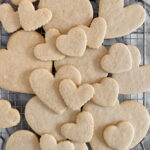butter cut out cookies
This butter cut out cookie has a lower ratio of sugar to butter and has a more tender crumb with a soft texture similar to shortbread.
- Yield: 2-3 dozen 1x
Ingredients
226g (1 cup) unsalted butter, room temperature
125g (1/2 cup + 2 Tbsp) granulated sugar
1 1/2 tsp Diamond Crystal kosher salt, or 3/4 tsp regular table salt
1 tsp vanilla bean paste or extract
1/2 tsp almond extract, optional
300g (2 1/2 cups) all purpose flour
Instructions
In the bowl of a stand mixer fitted with the paddle attachment (you could alternatively use a hand mixer and a mixing bowl), beat the butter on medium-low speed until smooth. Add the sugar and the salt and mix on medium speed until combined, scraping the sides and bottom of the bowl to ensure that everything is well combined. Add the egg, vanilla, and almond extract (if using) and mix until emulsified, scraping the sides and bottom of the bowl at least once to ensure everything is combined. The mixture should be homogenous, smooth, thick, and glossy.
In a separate bowl, whisk together the flour and baking powder. Add the dry ingredients to the butter mixture and mix on low until the dough comes together. Be careful not to over mix.
Drop the dough onto a lightly floured piece of parchment paper. Sprinkle some additional flour on the surface of the dough before covering with a second piece of parchment. Roll the dough to 1/4″, or up to 3/8″ for a very thick cookie. Place the dough in the refrigerator to chill for 1-2 hours or in the freezer for 10-20 minutes.
Preheat the oven to 400 F.
Cut shapes from the chilled dough with lightly floured cookie cutters, placing the cut cookies on a parchment lined baking sheet. Chill the cookies in the refrigerator for 10-15 minutes or in the freezer for 5 minutes. Bake the cookies for 8-10 minutes, or until the tops are no longer shiny. The size and thickness of the cookies will determine how long they bake, so pay attention to the surface and the bottoms of the cookies. The surface should be no longer shiny, and the bottoms should be golden brown.
Cool the cookies on the cookie sheet for a few minutes before transferring them to a wire rack to cool completely before decorating. Moving them prematurely can result in broken cookies.
Decorate with buttercream or royal icing.
Notes
- This recipe makes 2-3 dozen cookies depending on the size of the cut cookies, the thickness of the roll, and the amount of times the dough is re-rolled.
- I like to re-roll my dough one or two times, maybe three at the most. The best method for re-rolling is to collect the dough scraps all at once at the end of cutting the cookies from all the sheets of dough. Then I gather them into a new dough ball and roll out again. Sometimes the dough is too soft to cut shapes, so I put the sheet in the freezer for 5 minutes to re-chill the butter before cutting cookies again.
- This recipe works best when rolled to 1/4″ or 5/16″ for a softer cookie. If you’re looking for a thinner, crunchier butter cookie, lower the flour to 270g and roll to 1/4″ or 1/8″.
- If you feel that 400 F is too high for your cookies, and you prefer less browning, lower the temperature of your oven to 375 F and make a note for next time.
- Room temperature butter is important in this recipe. Using cold butter can result in little curds of cold butter throughout your final dough, which causes the cookies to spread randomly and look strange. If your butter is coming straight out of the fridge, microwave it for 5 seconds, flipping it over and microwaving it again for 5 seconds until it is pliable. Be careful not to soften it too much.
- Mise en place’ is a French phrase with the idea of putting everything in its place before beginning to make a recipe. It helps everything to go smoothly and eliminates so much possible stress. Getting all of your supplies and ingredients together beforeever starting the recipe will help tremendously.
- Weigh your ingredients, particularly the flour. It is the most important measurement in this recipe to weigh. Flour can be off in volume measurements by up to 30g, which is a quarter cup! Having incorrect flour measurements can cause your cookies to spread too much or, alternatively, be dry and crumbly. Weighing your ingredients makes everything so much easier, as you don’t have to wash all the measuring cups at the end. However, I do not use the scale to weigh out teaspoon or tablespoon measurements for things like baking powder, salt, vanilla, or cornstarch, for example.
